
Dr St John Simpson in the Great Court at The British Museum Photograph: Dr S.V. Pankova
Dr St John Simpson is an archaeologist and the Senior Curator in the Department of the Middle East at the British Museum, where his area of oversight also includes Afghanistan, Iran, and Central Asia. He has excavated extensively in the Middle East and Central Asia and from 1992-2000 co-directed an international collaborative project at the important ancient city-site of Merv in present-day Turkmenistan. His research delves deep into Sasanian and early Islamic-Late Antique and early medieval material culture from Iraq, Iran, the Persian Gulf and Central Asia, as well as ancient South Arabia. Some of his best-known exhibitions at the British Museum are “Queen of Sheba: Treasures from ancient Yemen” (2002), “Afghanistan: Crossroads of the Ancient World” (2011) and the most recent “Scythians: warriors of ancient Siberia” (2017/18).
St John Simpson has been a key player in the successful collaboration between the National Museum of Afghanistan, the British Museum, the UK Border Force, the British Metropolitan Police Service (Art and Antiques Unit) and others in the return of stolen antiquities to Afghanistan.
When Britain implemented the Dealing in Cultural Objects (Offences) Act 2003,[1] it became unlawful to import objects known to have been illegally excavated in or exported from another country. The law also covers objects that have not been stolen, but have been illegally excavated or removed from a monument. UK law enforcement asks the assistance of experts to determine the authenticity and origin of seized objects.
Introduction
Cultural Property News has published a number of articles setting out how Western institutions are rethinking their relationships with source countries and moving towards collaboration with museums worldwide. British Museum Director Hartwig Fischer addressed how these responsibilities are balanced with the museum’s obligations to preserve and study their collections in “Collections entail responsibilities: Notes on a global institution.”
Day-to-day, in your curatorial work, you are also dealing with war and the complete disruption of ordinary life in almost every region you cover. I wanted to talk about specific aspects of your collaborative work with institutions in Afghanistan and in Iraq and other Middle Eastern countries, on how these partnerships have evolved to meet the needs and capacities of the museums there, and of course about your work to repatriate looted objects to Afghanistan.
You have a truly unique position, working to connect all the parties involved in the circulation of art – where you can see the whole picture. You stepped forward recently to point out that cultural policies in Germany in particular were being driven by misrepresentations about the illicit circulation of art. Can we talk about that first, and get the unreal picture out of the way, and then talk about the realities, and the way forward?
St John Simpson: Yes, let’s get the ILLICID report out of the way.
The key fact about the ILLICID report is that out of the sample of the 356,500 objects that they say they looked at, only 0.1% were identified by them as genuine pieces from Syria or Iraq. That is very telling. I think it implies that there is a considerable amount of hyperbole about the volume of trafficking from those countries at least, even though there has sadly been a lot of destruction across the country. That hyperbole is something that we’ve seen in a lot of press stories over the last few years. Compare that to the fact that in the last nine years, we’ve not seen a single antiquity entering Britain or passing through Britain from Daesh-controlled areas of either Syria or Iraq. That’s despite the fact that the UK is a major transport hub and there has been very high-risk profiling of individuals and freight from Daesh-controlled areas. We have also yet to see any objects on the market which we can show might have been stolen from the Mosul Museum in 2015.
I think that the absence of any such objects that we can demonstrably prove comes from these past nine years of conflict is very telling. It’s in complete contrast to the decade-long period from 1993-94 to 2003-2004 in Iraq where the satellite imagery of the ground matched the market picture. At that time there was organized looting of sites known to produce cuneiform tablets, glass, seals, coins, bullae and those sorts of things and we had huge quantities of those things on the market. That’s also a period when there was looting at museums and museum pieces were identified on the market. So in Iraq, in that decade, there was a complete match between the different data sets, whereas in Syria and northern Iraq in the last 8 years there’s a complete mismatch. That is something that needs to be better analyzed and explained. And I think that’s where future scrutiny ought to lie.
What does it mean that you haven’t seen recently stolen pieces from the Mosul Museum on the market anywhere?
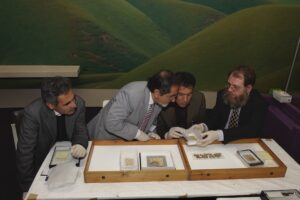
St John Simpson and staff of the National Museum of Afghanistan and the Department of Antiquities condition checking newly identified Begram ivories previously stolen from the National Museum.
Photograph: David Agar © The Trustees of the British Museum
St John Simpson: I am not aware of them showing up anywhere internationally although pieces stolen before have. I’m afraid that the conclusion is potentially quite grim. That is that the Daesh propaganda, whether spoken, written or visual, emphasizes, as propaganda did in 2001 in Afghanistan, the destruction and defacement of imagery, which was seen to be a powerful counter message to their own ideology. What we’re seeing is a very parallel scenario. The Daesh were in fact destroying; they were not digging for the market. If they were digging for the market or trading, then we would have seen those Palmyrene busts that got intercepted by Daesh at a checkpoint near Jerablus being moved across the border into Turkey. Instead they took them off the lorry and smashed them in front of a crowd of people that they whipped up and for the cameras to observe.
The same goes for the secret storeroom in Palmyra. We know that the Syrian Directorate General of Antiquities and Museums, just hours before Daesh took Tadmor, had whisked away large quantities of their stored antiquities. They relied on the fact that there was a hidden storeroom which no one really knew about to keep the remainder. Sadly, as we now know, the location of that storeroom was discovered by Daesh. They entered the facility, they beheaded all the sculptures and then walked away. Took none. They could have ghosted them all out of the country but they made no effort to. So I think this idea of Daesh in particular making millions of dollars out of traded antiquities is a complete myth. Or at least needs to be seriously supported by facts.
This is very important information coming from someone in your position.
St John Simpson: We have to look at and follow the evidence. That is what law enforcement does, and so do curators. In museums we are in an exceptional position because we know objects. That’s our bread-and-butter. We have to look at the market. We have to see what’s passing through it, genuine or not.
The British Museum is the key source of expert witness for all areas of UK law enforcement where objects are thought to have been stolen or trafficked, so we see it all. We see the export licences as well. This also applies to other national museums in other countries. So museums have an incredibly powerful role to play and to be a voice for the community as to what is really going on.
Museum professionals now work constantly with colleagues around the world, and this builds a cumulative historical understanding of how things work – wherever museum people are, they share this collective art historical memory of centuries. It seems that as a family, museum people share special traits and understandings as well as common goals.
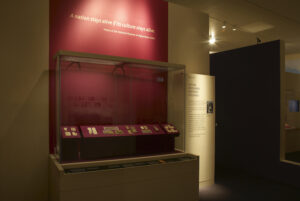
Begram ivories stolen from the National Museum of Afghanistan on special display at the British Museum in 2011 prior to their return to Kabul the following year. Photograph: John Williams © The Trustees of the British Museum
St John Simpson: The idea that museum people belong to one family is a powerful one, which is not really widely understood outside the museum sector. There are several aspects to that which are of great importance. One of the great lessons of the conflicts in Afghanistan, Iraq, Syria and Yemen, as in Britain and Russia in the Second World War, is that you’ve got to have a disaster plan. You should prioritize the high-value; move or hide objects as far as you can and share information on a need-to-know basis.
The curators, or keyholders as we call them from Afghanistan, who have been doing that are the heroes and heroines of cultural history for the past hundred years. When museum directors in those countries assure us that they can look after the objects that we’re looking to repatriate, we’re not in a position to doubt them. It’s not our business to act as depots for the long-term storage of other countries’ cultures if these pieces have been seized by law enforcement for the purpose of repatriation.
That’s where we do know and trust each other within the museum sector. That is not always appreciated by the public. There is often talk about the extent to which politicians understand or appreciate culture. I think the answer to that is that all politicians understand how important culture is because it’s the basis of manifestos, ideologies, national education curricula to some extent, and the tourism economy. In my experience, not a single politician is unmoved by the impact objects have on them if you explain what the significance of a given object is. One has to remember that politicians are people too and it’s really a case of making the right connection and showing that culture counts. That’s where the role of museums in bringing in politicians of all sorts, whether in power or in shadow roles is terribly important. We are centers of soft power and centers of neutrality, and we therefore have a very powerful role to play in advocating for the power of culture and speaking across borders as well.
If we talk about steps for the future, we can start with the challenging situation in Yemen. The BM already has a fantastic collection of South Arabian sculptures, and there are collectors who would like to donate objects that were collected before the recent crisis, but after 1970.
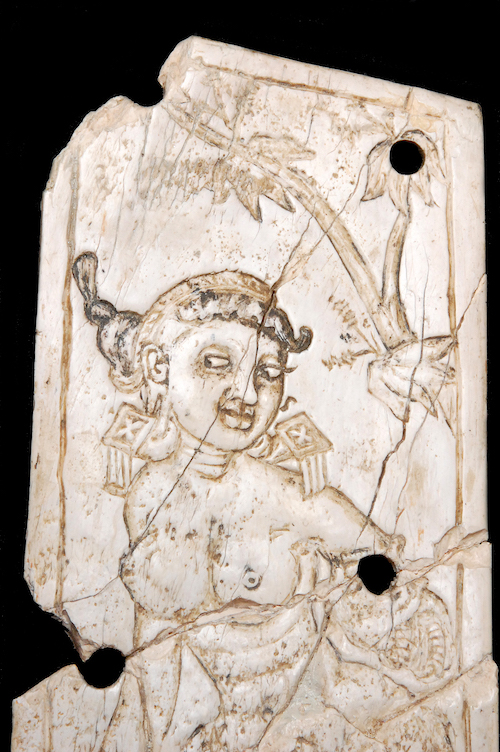
One of a group of ivories originally found in Begram, returned to Afghanistan in 2012. “[In 2001], thanks to the generosity of the art dealer John Eskenazi and additional support from the exhibition sponsor Bank of America Merrill Lynch as part of its Art Conservation Project, we were also able to accept, conserve, analyse and exhibit a spectacular group of 20 carved ivory and bone furniture overlays. These date to the first century AD and had been excavated in the 1940s by a French expedition to the ancient city at Begram. These had been stolen from the museum in Kabul during the civil war and had previously been feared lost forever. We published a small book on these pieces, as well as two journal articles and a long monograph, and sent the objects back to Kabul in 2012, where they are safe.” St. John Simpson, Art in crisis: identifying and returning looted objects, The British Museum blog, 5 November 2019 © National Museum of Afghanistan / The British Museum
Is it foreseeable there could be safe collections in Yemen, and that it would be possible to have cooperative relationships that would further the goal of sharing objects? Where do you start to heal the system?
St John Simpson: I think that would be amazing if that were to happen. One of the extraordinary initiatives that was announced at the Hermitage last December was what Dr. Mikhail Piotrovsky has done to help establish a conservation laboratory in the National Museum in Muscat, Oman for the conservation of pieces from Syria that have been damaged in the war. That obviously acts as an in-Arab-country conservation training center for pieces that come in and out of Syria. I think that’s quite an extraordinary idea for capacity-building within the region. The British Museum has a big exhibition on Assyria which was just coming to an end so I went to St. Petersburg for the close and the closing conference they were planning. Global events rather overtook us, and we now have an exhibition under lockdown, but that’s the case for exhibitions all around the world at the moment. And the conference was canceled, obviously, but hearing about that initiative came out of that process.
The choice of Oman is quite brilliant. It’s a neutral country. It values cultural heritage. It talks to many of the players within the region and yet has not gotten drawn into regional conflicts. And they have a great new National Museum. I think the choice of that museum and that country is really inspired. I think it offers a way forward into the future for other countries to collaborate through them.
Politicians are often very quick to grasp the power of objects to move people, but they tend to look for someone to blame. Sometimes, there are monsters. In Syria, we’ve seen Hama again and again.
St John Simpson: What we need to do is to try and see the restoration of peace and order as soon as possible and the rebuilding of international and collaborative links through culture and in time it will become evident what really happened there.
History is full of monsters. We can’t tame monsters and we can’t kill monsters but we can outlast all governments. That’s what museums do. The British Museum is about the same age as Afghanistan as a country [Ed. the British Museum was founded in 1753 and the rule of Ahmad Shah Durrani began in 1747], and we have each of us seen a succession of different governments of different complexions throughout our respective histories and yet we talk to their National Museums and they talk to us and we trust each other. That’s the most important thing in the end. We’ve got shared ideals.
How can museums best use their soft power today?
St John Simpson: One very important thing is training. We have two very successful programs. One is the International Training Program, which takes curators every year from different countries around the world. We’ve had curators from Afghanistan, Yemen, Iraq and Iran. They’ve gone back to their institutions and are still working there. So that builds on what we do. We get to know them and they get to know our processes. Secondly, we are in the final year of a five-year British government-funded training scheme for Iraqi archaeologists, all professionals. If we can get funding to extend that scheme both in Iraq and elsewhere, we’d like to do that. One of the things we’d really like to do if we can is to think about developing a scheme for Syria. That would perhaps be longer term, sadly, as would be a scheme for Yemen.
What works and what has been less helpful?
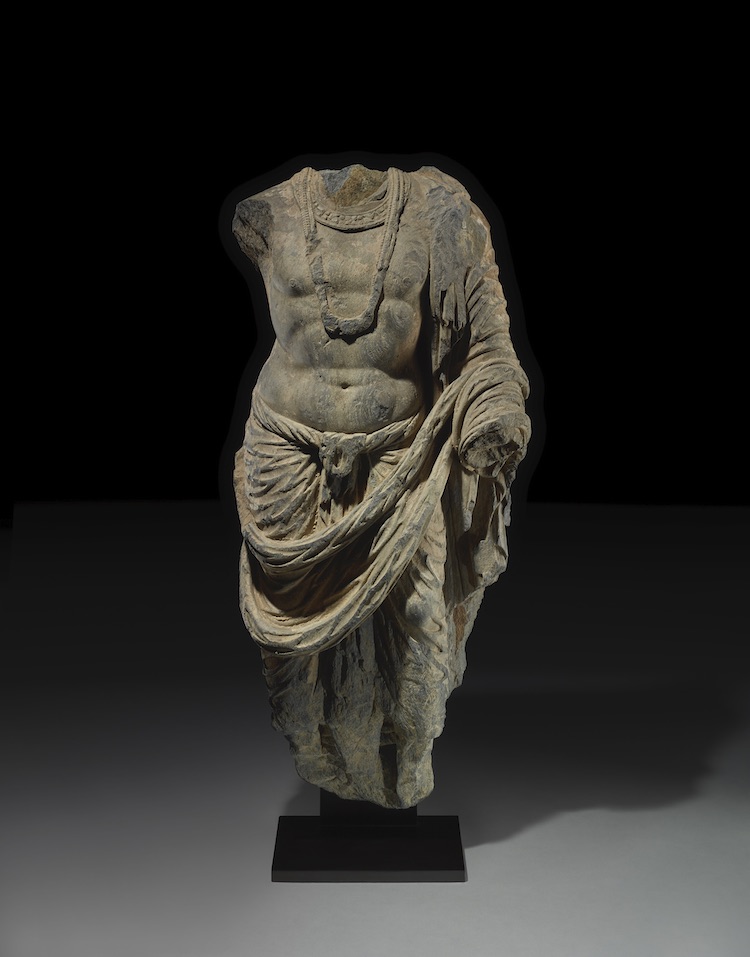
Bodhisattva sculpture, grey schist. Afghanistan, 4-6th C. This sculpture was seized together with the nine stucco heads in a shipment from Pakistan. Photograph: Jo Fernandes © National Museum of Afghanistan/ The British Museum
St John Simpson: There is a common tendency today to look at bespoke databases and remote sensing. I would suggest caution with both things. I don’t think bespoke databasing is an answer to understanding trade and I don’t see or hear much appetite for that approach among our stakeholders in the host countries we work with.
Their views need to be put forward first. It is by training together on practical issues that we can best move forward: how you record objects, how you pack objects, how you tell genuine things from fakes, how you prioritize what you record. Those are really important curatorial skills and we teach them to our own curators and we try to share that information with our trainees in other countries.
Then you start to hear and see what they want and need. That’s where the needs analysis has to grow from, rather than developing it from sitting around a table in a building in the West and saying we need this database, we’ve got to have that database. It falls down because they don’t trust databases, they don’t have the power to run the databases, they don’t understand the vocabulary behind the databases and they aren’t used to dealing with databases because they don’t use them on a day-to-day basis, at least in the cultural sector. I and a number of colleagues have a real concern about that approach.
Databases and satellite tracking can give you the facts about how many holes there are but that doesn’t tell you what’s driving the digging, or what was found there. You might be familiar with a recent study where they counted the objects and their sizes that had been found in well-documented archaeological sites and compared this to the values of objects of similar size sold at the biggest auction houses and took that as the value of the objects that would have come from looted sites. These things don’t have anything to do with each other. This is what happens when you don’t do field research.
St John Simpson: There is a whole generation of archaeologists now that has got PhDs and got jobs based on using remote sensing because they couldn’t get to the countries on the ground. The problem is it’s like diagnosing cancer with a CT scan. It’s slightly pointless unless you can operate. I totally agree it needs to be followed up wherever you possibly can with ground research. You’ve got to look at these sites.
On the other hand, it could be a tool for law enforcement.
St John Simpson: Yes, and that is something that needs a whole new approach. The Iraqis have got a very well-trained and very intelligent archaeological police service who operate jointly with the Ministry of Interior and the State Board of Antiquities and Heritage. They patrol the landscape, talk to locals, they follow up on any reports of looting, and they protect the archaeologists, museums and monuments.
It seems to me that working with organizations like that and going back to some of those looted sites where there’s a lot of data still there, you could get a much better handle on what is driving the looting and understand the difference between organized and ad hoc digging. From that you could start to manage those sites. Those sites are still full of archaeology; they’re not totally destroyed. You could turn them into training grounds basically, to retrieve data from what are effectively crime scenes. That is a whole new approach that could really be grasped and developed for the good of archaeology, for the good of the national archaeological service and for the police there and abroad. That’s one tremendously exciting way forward that we would like to do ourselves.
What are your working relationships in Afghanistan?
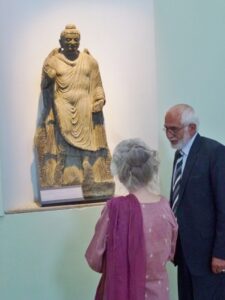
Dr. Omar Khan Masoudi, Director of the National Museum of Afghanistan, and the late Nancy Hatch Dupree attend the opening display of the ‘fire Buddha,’ after its return to Kabul. The sculpture was found in 1965 at Sarai Khuja, north of Kabul. It was exhibited in the National Museum until it was wrenched from the wall one night in 1996. It had entered a private collection in Japan and, after much discussion, it was acquired on behalf of the National Museum of Afghanistan by John Eskenazi who presented it in memory of the late Carla Grissman (1928–2011), who did much to work with the Afghan museum staff and who was one of the founding members of SPACH (Society for the Preservation of Afghanistan’s Cultural Heritage).
Photo © Andrew Miller
St John Simpson: We work with museums as we are not a university, although we have some PhD students. Museums are our comfort zone. In Afghanistan we work very closely with the National Museum of Kabul. We have so far repatriated just over 2,300 antiquities of all periods seized by law enforcement since 2003 and we’ve developed a very efficient protocol with Kabul. Whenever we are made aware of an object or a group of objects and we are sure that they have come from Afghanistan, we notify the National Museum in Kabul and then they effectively empower the British Museum to act on their behalf. We contact the Afghanistan Embassy in London and we create a report on the objects and we are allowed, if we have got the resources, to scientifically analyze the objects and we are allowed to display them. We have a dedicated showcase for that material. We’ll do a press release jointly, a handover ceremony to the Embassy and they will return the objects to the National Museum. It’s a tremendously successful protocol and it’s now been adopted by several other countries in the Middle East.
Of these 2300 antiquities returned since 2003, can you describe the types?
St John Simpson: We’ve had all sorts from Bronze Age cemetery material from the Mazar i Sharif area, we’ve had pottery from more recent looting down in the south, we’ve had a small number of pieces from the Hellenistic period that may come from Ai Khanoum. We’ve had Islamic metalwork, ceramics, and Gandharan Buddhist material – pretty much a representative range of Afghanistan’s history starting around 2500 BC.
Are there a lot of coins?
St John Simpson: Not very many actually. Coins have been a little bit more difficult to prove where they are from. You may have the place of minting but coins circulate internationally, whether they are of low denomination or high denomination. Unless they are in a consignment where we are very sure that they all come from one place we’ve had limited success returning coins. Non-collected coins of any value – for example silver coins simply get melted down.
How much of it is fake?
St John Simpson: There was some fake material amongst those that we sent back. Because they were mixed consignments, we felt it was appropriate to send it all back and not be the judge as to whether something should stay or not. The decision about the retention policy should be made in Kabul. It’s true that we see far more fakes than genuine artifacts on the market. That’s again something that has been underestimated and under-reported. There’s a huge industry out there producing fakes because it’s much cheaper and much safer to make objects that are complete than it is to hire dozens of workmen to go out into what is potentially a conflict zone and dig and bribe and pay middlemen along a chain. It is unsurprising really on economic grounds why there are so many fakes.
Now, the internet is a perfect platform for the sale of fakes and low-quality material. The buyer cannot see the object except through an image, which may be a poor-quality image, particularly when they are using social media platforms.
It’s not an art trade, it’s a scam.
St John Simpson: It’s fraudulent activity of a different sort. You can’t trace the seller very easily. We’ve been shown images of objects by individuals and organizations where there was good reason to think that these objects were in Syria or had been recently exported from Syria but in every single case when I sat down with somebody and looked at these images they were all fake. The level of disappointment for law enforcement is quite palpable. You’ve got these very serious people hoping to press charges and we say actually all we can tell you is that it’s not genuine. It’s not worth any money, and there is no income stream coming from it.
The objects that I saw in Afghanistan in the 1970s were mostly real. But in Peshawar or in Swat in Pakistan, not only the things for sale in the bazaar, but even the objects in the museums were often fakes. They had been switched out for the real ones.
St John Simpson: There is a story that can trump that one. Claudius James Rich, the political resident in Baghdad at the beginning of the 19th century, went to Babylon and acquired a number of cuneiform tablets. No one could read them. It was almost half a century before anyone could read cuneiform. But because they saw him coming, probably quite literally, at the head of a small cavalry troop, they started to produce fakes. We have as many fakes as we have genuine objects in the Rich Collection at the British Museum, from the beginning of the 19th century.
That’s supply and demand! The media only talks about looted treasures. I suppose they don’t want to disappoint.
St John Simpson: Exactly. But the facts are not as widely reported or recognized as much as they should be. If we can come up with a different angle, in our experience, we will get the story to the public. You asked about James Cuno, and his statements that museums are the best place to really discover an object’s history.
That is an important point that should be made. Museums are for everyone; they are for people of all ages and all backgrounds. Our role is obviously to educate and enlighten but it’s also to surprise people and to bring cultures to life and make every object relevant to that individual.
Knowing where something comes from obviously helps us tell a story but we shouldn’t discount the orphans because they have a part to play too. One of our goals and challenges as museum curators is to wring out from every single object, provenanced or unprovenanced, what its story is and what its relevance is. That is something that is worth emphasizing.
There is material that has come out of Afghanistan over the last forty years of war that hasn’t been discussed in the scholarly world because of its antecedents. Archaeological context is not absolutely required in order to do art history. Some say it’s foolish to close your eyes to this material.
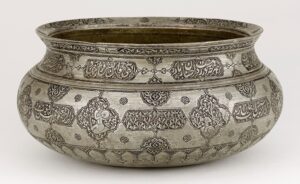
Safavid bowl, tinned copper, dated 1604/1605, which had been looted from the National Museum of Afghanistan in Kabul. © National Museum of Afghanistan / The British Museum
St John Simpson: I do agree. It is easy to classify the world in black and white, but the world is polychromatic in multiple shades. We shouldn’t ever exclude the possibility of getting any information we can from objects. We have scientifically analyzed some of the looted material we had before sending it back to Kabul. We’ve had very specific questions in mind.
For instance, we’ve had some of those little Bronze Age cosmetic jars that often have applicators still in position or traces of the residue. But very few analyses have ever been done or at least published of the cosmetics, so we thought it would be really interesting to take a range of those containers and analyze the contents. We could try to understand what the beauty industry was like in Bactria in the year 2000 BC.
Secondly, we had a group of carved wooden objects. I heard almost as many different interpretations of their age as you could imagine: Bactrian, ethnographic, medieval, and everything in between. We thought, we’ve got permission from Kabul to analyze. There were fragments in the box. So we looked at the wood and then we radiocarbon dated them. When we radiocarbon dated them, it showed that they were carved from wood in the 1990s. They are all modern fakes, but there is now a whole genre of fakes out there, which we have even seen passing through an online auction. Now we can recognize a class of fakes that we had not known about before. And we’ve given that information back to Kabul along with the objects. In a very small way, we have moved the subject forward. Those are two little cases where we have made a little bit of a difference by looking out for orphan objects.
And the amazing stucco heads now at the British Museum?
St John Simpson: We haven’t yet returned them because we are under lockdown. They are fantastic pieces. A couple of crates coming in from Peshawar caught the eye of Border Force at Heathrow. After a long running investigation by the police and Her Majesty’s Revenue and Customs into the importer they were finally disclaimed. That’s when we were able to announce their presence. Polychrome painted stucco heads, bodies probably still in the ground, and a headless bodhisattva of gray schist. It’s clear from looking at the neck that the piece has been beheaded in recent times. It’s not an old break. I wonder whether we’ll ever identify that head somewhere in a different collection one day. That would be an amazing moment. Likewise, I do wonder where the bodies of the stucco heads lie. Are they from an unexcavated part of Mes Aynak? Or from another site somewhere in Afghanistan? They must be somewhere.
Stylistically, what do you think?
St John Simpson: It’s one group, 4th to 6th century. There are some general similarities with the heads from Hadda. But the sites in the Hadda area were looted a long time ago or excavated a long time ago. I think they are much more likely to come from another place and Mes Aynak is an obvious possibility. We don’t know much about what has been found at Mes Aynak apart from what’s in the catalog of the exhibition in Prague and what’s on display at the Kabul Museum. We don’t know what is still unexcavated. It’s a huge complex.
When you have spectacular pieces like the heads, are you able to do 3D imaging so that you would be able to match them later to bodies?
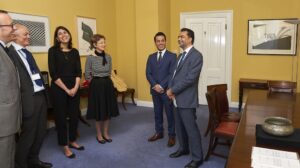
Ceremony to return the Safavid Bowl. Left to right: Jonathan Williams, Deputy Director, The British Museum; Tony Doubleday, Head of Legal Services at The British Museum; Sara Plumbly, Head of Christie’s Islamic Art department; Paola von Aulock; Yasir Qanooni, Cultural Attaché, Embassy of Afghanistan; Ahmad Zia Siamak, Chargé d’Affaires, Embassy of Afghanistan. Photograph: David Agar © The Trustees of the British Museum
St John Simpson: We are short of capacity for 3D imaging but we did do CT scans of them to try to understand how they were made. We can show graphically how the layers of stucco were applied. And we analyzed some of the pigments, so that we could give that data there to our colleagues in Kabul.
It is always a case of resourcing when it comes to analysis. In an ideal world we’d like to do much more of that, but it has always been a case of balancing the information that we can get from pieces that are not ours against what we should be doing to research our own collection.
Going back to what you were saying about the lack of utility of what is being done with satellite imaging, is the most beneficial use of the technology that is available today to document objects, not holes in the ground?
You can now photograph an object at an archaeological site and send the data to the Cloud with exact GPS coordinates and links to everything found nearby. You can document all objects in museums. It’s not only relevant information, it also means that stolen objects can never be sold, or if they are, you can get them back.
St John Simpson: That’s right. I completely agree. That is one of the lessons we have learned unfortunately several times from recent conflicts; the primary task is documentation of collections. I don’t just mean national museums but local museums and archaeological depots. Those are by definition less well protected than national museums. Document that material with good photographs.
Capture those data and put them in multiple safe places. One gets the impression that there is not enough backing up of the data. We would advocate that much more effort goes into that. That’s a whole area of continuing discussion with countries and museums around the world. It is not for us to advise other museums what to do, but if everyone realizes that’s a vulnerability in the system, then that needs to be addressed.
Where should resources be directed besides training and documentation?
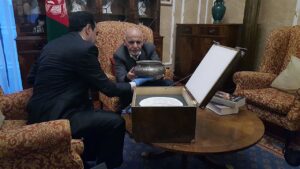
President of Afghanistan Ashraf Ghani at the Embassy of Afghanistan in London, viewing the Safavid period bowl returned with the help of the British Museum. Photo: Embassy of the Islamic Republic of Afghanistan
St John Simpson: Those two are important. It’s got to be practical training. One of the things that recently came up with our discussions with our friends in the National Museum in Kabul was a more practical publication of what’s been stolen and what’s been returned. We have the UNESCO publication which is unusable because it mixes up objects which we know are in Kabul, or in international travelling exhibitions, with objects which have been stolen. They are arranged in an academic fashion which makes it very difficult to use if you are not an academic, like law enforcement.
The question posed in Kabul was whether a new publication would be useful, and that would be relatively easy to do. Following on from that, full publication of what is returned and repatriated to foreign countries is very important to make the process transparent. We know of some countries returning large quantities of material to Iraq and to Afghanistan. However, with the exception of what the British Museum has listed and put out through the press, we’ve got very little idea what those objects are. We know that our colleagues in Baghdad and Kabul and other capitals in the Middle East would welcome full publication of objects when they are repatriated for the same purpose. We would then be able to see patterns in the market and start to work more collaboratively across countries, not just Britain and Afghanistan, but maybe Britain and America or with other European countries. We could extend this process we’ve begun of having showcases on repatriation, so that when objects go back they can be seen and appreciated by wide members of the public, and everyone can understand what museums do when they work together.
Transparency would be of huge importance to private collectors and to art dealers too. People who collect art are generally not billionaires with private museums, they are people who are passionate about the works. They feel responsible for them like children and they don’t want to send them off to somewhere where they won’t be cared for. The collaborative building of cultural institutions is absolutely key and if the institutions are respectable places to send your children then the objects will follow. It would enable a whole different level of magnitude of collaboration with museums in source countries. That would be a beautiful world.
St John Simpson: I have emphasized perhaps too much the role we have played in law enforcement. We have worked with private individuals including dealers in repatriations. One private couple bought a bowl in Jeddah decades ago in good faith. This was before passage of Britain’s 2003 law on tainted objects. Many years later they took it to Christie’s where they recognized it as having been published by Souren Melikian-Chirvani as from the Kabul Museum. There were some sensitive conversations to decide the best way forward and the owners did agree to presenting it to Kabul. There was a handover ceremony as we generally do, with the deputy director and legal services, the owners, Christie’s and the Afghan Embassy. Then that night the box was opened in the embassy in London and Ashraf Ghani was there by chance. Ashraf Ghani took it back with him on the plane to Kabul the next day, with Karzai. Our friend in the National Museum got a phone call a few days later from the palace inviting him in person to go and collect it, personally. So the bowl is now on display in the new Islamic gallery in the Kabul Museum. That is a really positive story and heartwarming and beneficial for everyone as well as a challenge to have pulled off.
And the politicians involved will never forget that they played a role.
St John Simpson: Yes. Ashraf Ghani’s face when the box is opened and he is presented with the piece to take back. You should see the picture!
Notes:
[1] This law goes further than the UK’s Theft Act (1968): it covers objects that have not been stolen, but have been illegally excavated or removed from a monument. A cultural object will be ‘tainted’ if, after the date of commencement, a person removes an object from a building or structure of historical, architectural or archaeological interest where the object has at any time formed part of the building or structure or removes an object from a monument of historical, architectural or archaeological interest. A criminal prosecution requires that an individual dealing in the object knows or believes that it is tainted. The law extends to England, Wales, and Northern Ireland. It is not effective in Scotland. https://www.legislation.gov.uk/ukpga/2003/27/contents.
Additional reading:
St John Simpson, ‘Stolen, saved, returned: collaboration between the NMA, BM, UK Border Force, and others in the successful return of antiquities to Kabul’, Preserving the Cultural Heritage of Afghanistan. Proceedings of the International Conference Held at Kabul University, November 2014, edited by Gil J. Stein, Michael T. Fisher, Abdul Hafiz Latify, Najibullah Popal and Nancy Hatch Dupree (Oriental Institute Chicago 2018)
St John Simpson, ‘The “Begram Ivories”: A Successful Case of Restitution of Some Antiquities Stolen from the National Museum of Afghanistan in Kabul’, International Journal of Cultural Property 23 (2016): 459–477
Janet Ambers et al., Looted, Recovered, Returned: Antiquities from Afghanistan (Archaeopress 2014)
Emma Passmore et al., ‘Hidden, looted saved: the scientific research and conservation of a group of Begram Ivories from the National Museum of Afghanistan’, The British Museum Technical Research Bulletin 6 (2012): 33–46
St John Simpson, Afghanistan: A Cultural History (Interlink 2012)
St John Simpson, The Begram Hoard. Indian Ivories from Afghanistan (British Museum Press 2011)
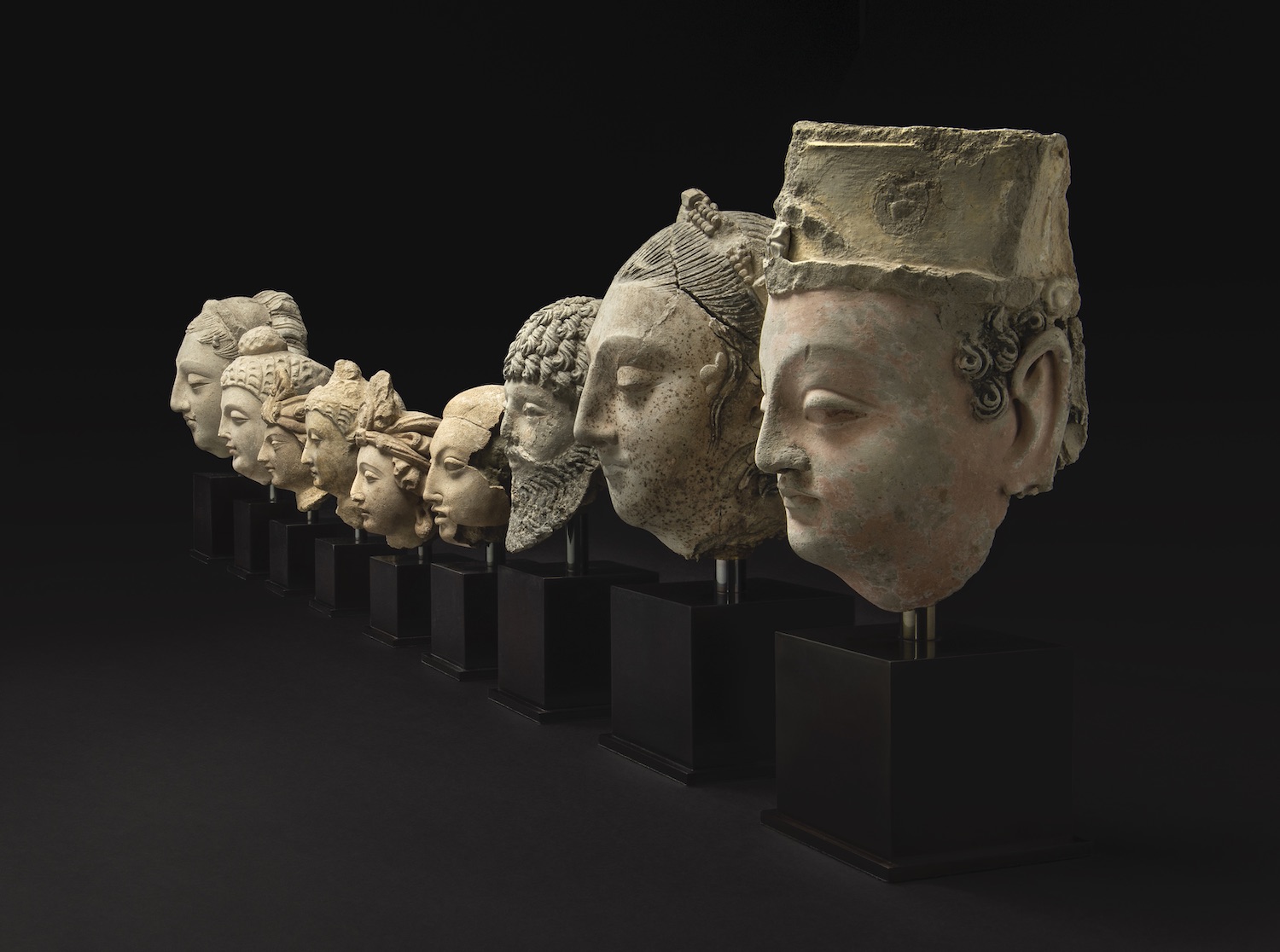 Nine heads taken from Buddhist sculptures somewhere in Afghanistan. Stucco, some with residual painted decoration. 4-6th C. CE. These sculptures were seized almost two decades before in the UK as part of an operation involving the Art and Antiques Unit of the Metropolitan Police and brought to the British Museum for identification. They will soon be returned to the National Museum of Afghanistan in Kabul. Photograph: Jo Fernandes © National Museum of Afghanistan/ The British Museum
Nine heads taken from Buddhist sculptures somewhere in Afghanistan. Stucco, some with residual painted decoration. 4-6th C. CE. These sculptures were seized almost two decades before in the UK as part of an operation involving the Art and Antiques Unit of the Metropolitan Police and brought to the British Museum for identification. They will soon be returned to the National Museum of Afghanistan in Kabul. Photograph: Jo Fernandes © National Museum of Afghanistan/ The British Museum


